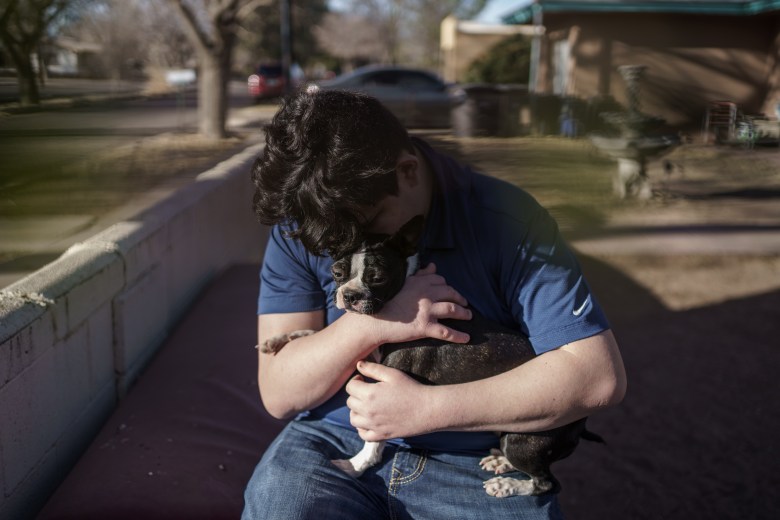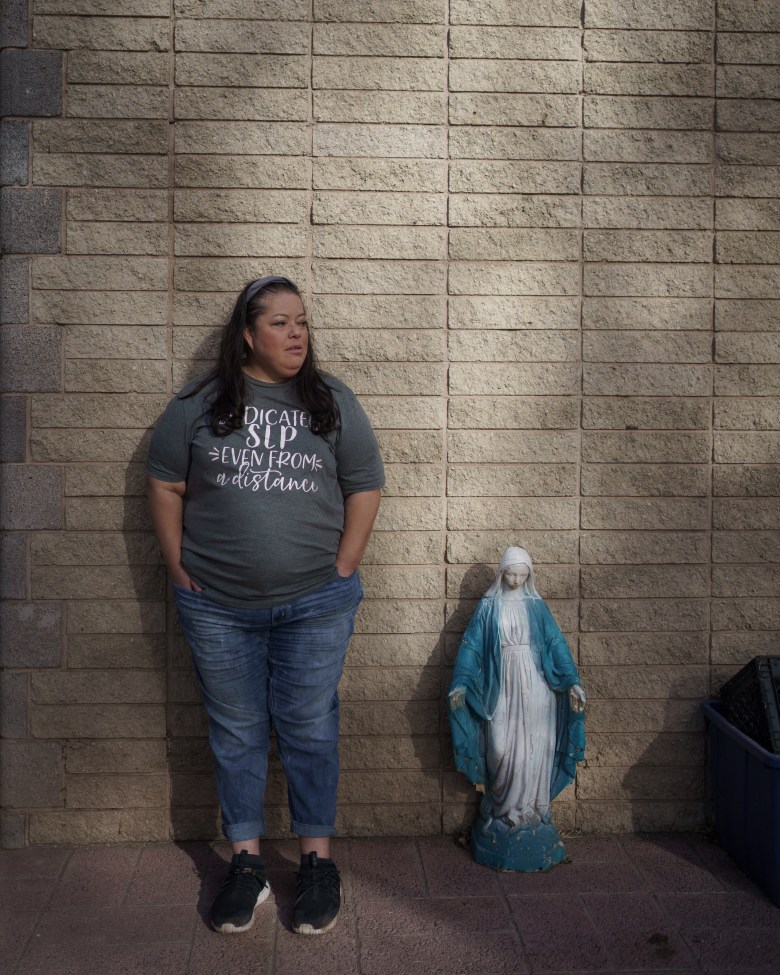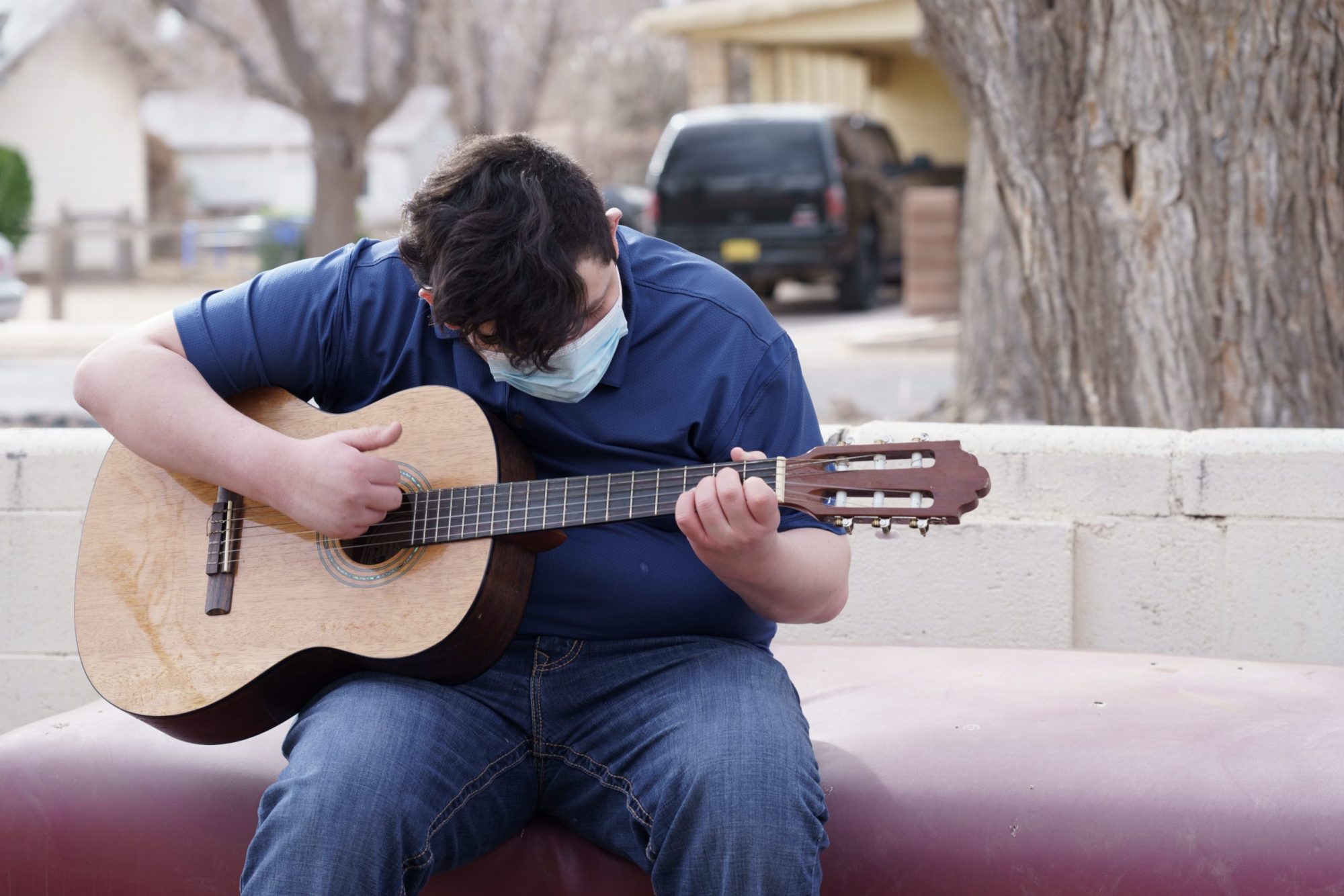Pep rallies are supposed to be joyful, loud and unabashed. Having just turned 12 in the fall of 2017, Alan bubbled over with excitement ahead of his first rally at Deming Intermediate School in Deming, New Mexico, a small city near the Mexican border.

Classrooms aren’t easy for Alan, his mother said. (We are using Alan’s middle name to protect his privacy.) She described him as a gentle, soulful boy going through life with a collection of medical conditions including Tourette syndrome. His tics and shouts, all beyond his control, make him an easy target for bullies and, to some school staff, a problem student to be corrected.

At the rally that October day more than two years ago, Alan began stomping and shouting, cheering for his new school. The noise was too much for some classmates one bleacher row down from his.
The girls sitting there told school staff he was kicking them — a claim Alan and his mother, Juliet Moreno, deny.
“Everyone was doing it,” Alan said recently, recalling that day several years ago. “I was just doing it too. What did I do?”
“You don’t punish a child by denying them an education.”
Raymond Pierce, president of the Southern Education Foundation
Nevertheless, the meeting in the principal’s office that followed ended with Alan suspended.
“My son loves school. He loves to learn,” Moreno said. “He was crying on the way home, saying, ‘I don’t want to miss school, Mom.’ ”
It wasn’t meant to be a day for tears, but there Alan was, a tall, sturdy boy with thick black hair and wet cheeks, sobbing in the passenger seat of his mom’s Buick.
Alan was suspended for three days that time. A scuffle a few months later, Moreno said, netted him a week out of school and a visit from police at their home. School officials did not respond to multiple requests for comment.
Moreno worries about how schoolhouse sanctions could put her son on a path toward the criminal justice system. She’s right to be concerned.

Most American children who age into the criminal justice system do so in middle school — every state allows for the prosecution of children as young as 12, though most set the threshold earlier, or not at all — and suspension from school is predictive of incarceration later in life. For Black, Native and Latino boys, like Alan, research by the U.S. Commission on Civil Rights shows the impact to be especially severe.
And while the pandemic closed middle schools across the country, it doesn’t appear to have shut down school discipline. It is too soon to have firm data on suspensions, expulsions and school-based arrests during the pandemic, but some experts working directly with children of color say police are now often just sent to kids’ homes.
Amanda Gallegos, a staffer with SouthWestOrganizing Project in Albuquerque, which aims to empower disenfranchised communities, said the middle schoolers she works with are struggling.
Electives and school activities have been curtailed, said Gallegos, a field organizer whose work includes running youth programs and political actions. School discipline, she said, has been handed to police, who make “welfare checks” on students who miss online classes.
“Middle school, that’s when you’re figuring out how to be a human,” Gallegos said. “We always call it the equalizer,” she said, adding that middle school tends to be a crummy experience for most people.
Both suspensions and arrests have been on a downward track after peaking in the mid-1990s, but hundreds of thousands of boys of color are subjected to both every year.
Some lament that decline and the apparent shift to relatively unproven alternatives. In a recent survey drawing responses from 1,219 teachers and conducted by the charter schools advocacy organization the Thomas B. Fordham Institute, an overwhelming majority of teachers viewed suspension and expulsion as useful to keep classrooms safe.

Softer, more holistic approaches to school discipline have nonetheless been gaining traction in schools nationally for the past two decades, but experts worry the shift is too slow. If the changes aren’t accelerated, they say, the risk of abandoning too many of this generation’s Black, Latino and Native children to the justice system remains high.
A middle schooler who has been suspended is, by some estimates, nearly four times more likely to end up convicted compared to demographically identical peers. Students suspended or expelled early in adolescence are often shunted into remedial classes and never returned to the mainstream. That means they’re not “reading Mark Twain and Shakespeare and Maya Angelou,” taking algebra or learning world history, said Raymond Pierce, president of the Southern Education Foundation. Some lose interest, drop out or wind up in jail.
Disruptive behavior must be dealt with, said Pierce, whose organization formed to help educate freed Black people after the Civil War. But he worries suspensions make things worse.
Over 60 percent — The proportion of Black seventh graders who were suspended in a single year at two Atlanta middle schools.
“You don’t punish a child by denying them an education,” Pierce continued. “The appropriate thing to do is meet the child where he or she is.”
Particularly galling both to experts and parents, discipline doled out in middle school often punishes behaviors that are entirely appropriate for 11- to 14-year-olds.
“If you just hang around middle school kids, you’ll see them pushing and shoving each other,” said Melissa Sickmund, director of the National Center for Juvenile Justice. “If adults do that, it is assault. But if it’s happening in a school and there’s no blood … that kid does not need to be arrested.”

Many of the systems aimed at America’s youth are out of sync with the science, according to a report released in 2013 by the National Research Council. The study’s authors pointed to a fluke of anatomical development — parts of the brain influencing pleasure-seeking and emotional responses grow faster than parts supporting self control.
“It’s not just a refusal to do right, it’s that inability that’s part of their development,” Sickmund said.
The lag becomes especially apparent in middle school, when children start really roughing one another up. Normal adolescent behavior, Sickmund said, winds up criminalized. While the impression is that high schoolers are more “crime-prone,” she said, middle school is when students are most at risk of arrest for non-injurious assaults.
For Black boys and other children of color the increased the risk of being punished at school begins as early as preschool, according to government data. And by middle school, the school-to-prison pipeline for Black, Latino and Native children can be unsparingly direct.
Local news headlines paint the picture: In August 2019, a police officer at a Farmington, New Mexico, middle school declared he’d “had enough” after an 11-year-old brushed by a school administrator on her way through a door. Officer Zachary Christensen, who was later convicted of child abuse in the attack and sentenced to probation, slammed the girl to the concrete outside her middle school and handcuffed her as school staff looked on. Appearing in a New Mexico court on Jan. 14, Christensen apologized, explaining, “I’m not a social worker and the way I was trained was how I responded.”
Related: Is the pandemic our chance to reimagine education for students with disabilities?
In January 2019, a Columbia, Missouri, girl arrested by mistake after a fight in her middle school’s hallway was jailed overnight. A video of the altercation, reviewed after she was jailed, showed she wasn’t involved.
Generations of advocates for Black students have made claims of broad racial prejudice among educators, an assertion that has been borne out by research. Studies have shown teachers are as biased against Black people as American society is broadly, and that school staff are likely to misread the expressions of Black children, seeing anger where there is none. Black students are also disproportionately punished for breaking dress codes and disobeying hairstyle restrictions and other minor misbehavior.
Sixty miles east of Los Angeles, “C” has been handcuffed four times by police at his middle school. (We are using C’s first initial to protect his privacy.) During one October 2019 arrest caught on the officer’s body camera, a Moreno Valley Unified School District officer knelt on C’s neck after dragging the 70-pound sixth-grader away from his desk in a special education classroom.
The 11-year-old’s alleged infraction? Throwing a rock near an officer the day before.
Speaking about the violence of his son’s schoolhouse arrest, C’s father, William, reflected on the tragedy that might’ve been. Months later, reckless force by police against another Black person, George Floyd, would end in a killing that shook the nation.
“I refused to let him go back to that school,” said William, who asked to be referred to only by his first name to protect his son’s privacy. “I feared for his life. I didn’t want to put him in another situation where the outcome could be worse.”
Like Alan, the New Mexico boy, C qualifies for special education. Officers placed at the schools aren’t trained to interact with children who have disabilities, C’s parents and their attorneys contend, and showed no compassion or skill in interactions with C.
C was kept handcuffed in a squad car for more than an hour before he was taken to a police station, according to a formal complaint made against the school district by attorneys representing the family.
C has since enrolled in a new school and has been doing well with distance learning, but William said the damage is lasting. He said his son, who dreamed as a kindergartner of becoming a police officer, no longer sleeps well and often comments that “everybody thinks he’s bad.”
“They put the children in a wrong state of mind,” William said of police officers in schools. “It makes them think they’re in a detention center or something like that.”
Related: ‘I can’t do this anymore’: How four middle schoolers are struggling through the pandemic
Moreno’s son Alan has avoided arrest, but only just. Police have popped in on their meetings with school staff. One day, Alan made comments at school that alarmed a teacher. Hours later, police officers were outside the Moreno home.
School staff members’ responses to Alan’s Tourette syndrome cut deepest, Moreno said. The syndrome is a neurological condition characterized by involuntary tics and, in rare cases, including Alan’s, profane outbursts. The best medicine is counterintuitive — if those nearby just ignore his occasional flinch or shout, he can just roll with them.

Instead, Alan has been bullied by peers and ostracized by school staff, said Moreno, who, with her attorney Gail Stewart, has taken administrative legal action against the school district.
Stewart describes a decision pattern she’s seen repeated countless times in her 21 years representing students with disabilities. What’s deemed in early elementary school as an academic deficit — difficulty reading, say — necessitating assistance is by middle school recast as a behavioral problem requiring correction. Discipline follows.
“The kids are struggling,” Stewart said. “They either shut down or act out.”
Toward the end of seventh grade, Alan was moved into a classroom by himself and taught by an aide. He wept when his mother told him he was being sequestered.
“Because I’m a single mom, we’re a team,” Moreno said. “This was the first time I had to lie to him. … I said, ‘We’ll make it cool.’ ”
11 — The age of one California boy violently arrested by campus police officers inside his middle school special education classroom.
The only other sweetener Moreno could offer was that the bullying would stop. Inside, the soft-spoken mother of two said, she felt like screaming.
Alan ended up spending much of eighth grade alone, too. Moreno said Alan overheard staff talking about him, suggesting, as a police officer did, that he was faking his disability.
“As an educator, I’m just appalled,” said Moreno, a bilingual speech pathologist of 18 years.
Related: Thousands of families in special education limbo
Suspensions increased steadily from the late 1980s through the 2011-12 school year and then fell precipitously, dropping 20 percent by the 2013-14 school year, according to a 2019 report to Congress by the U.S. Commission on Civil Rights.
Yet Latino, Native and multiracial middle schoolers are still disciplined at higher than average rates, and the risk that classroom misbehavior ends in a suspension or a court date is acute for Black students. A study that tracked nearly 1 million Texas seventh graders found Black students disciplined for some infractions at rates 31 percent above the norm. Researchers at UCLA found suspension rates among Black middle school students were double the average; in a single year at two Atlanta middle schools, more than 60 percent of Black boys were suspended.
Until 2018, suspensions and arrests were commonplace at Woodland Hills Junior Senior High School, then the educational home to most seventh and eighth graders in the 3,800-student district in suburban Pittsburgh. Woodland Hills gained notoriety after a 2015 incident that saw a school-based police officer throw a 15-year-old boy to a hallway floor and, with the principal’s help, shock him with a Taser for talking back to a teacher.
Suspensions, expulsions and arrests were pervasive in the district, where students of color currently comprise 72 percent of the student body. Its elementary-level suspension rates were among the nation’s highest.
Change came when a newly elected school board brought in a new superintendent, James Harris.
Harris, a former military police officer, corporate marketer and restaurateur, was a school administrator in demand in the summer of 2018. When the dynamic, detail-oriented Black schools leader chose troubled Woodland Hills, he said, his friends wondered why.
Two years later, he had radically restructured the district. A rundown alternative school and a divisive magnet school were closed, elementary school enrollment rules were reset and a middle school was built. And on-campus police were phased out.
“The high school principal and I always talk about how we’re fighting history,” Harris said. “But we figure that every day is a new day that we’re adding to our history.”
“We’re fighting history. But we figure that every day is a new day that we’re adding to our history.”
James Harris, Woodland Hills School District superintendent
The “real change” for middle schoolers, Harris said, was a shift in the district’s school discipline policies. When students are pulled from class now, the staffer who deals with them must return with them to that class so the student may ask for permission to come back. This gives the teacher control and shows the rest of the class the student has remorse.
The 2019-20 school year passed without a single expulsion, and disciplinary referrals in the district have fallen 70 percent, Harris said, freeing teachers to work with students on academics. He believes those connections have changed the culture.
“They say, ‘You treat us like real people, ’” Harris said of the students he’s met. “Well, you are real people.”
Moreno wonders who will see her son that way, as a person whole and worthy, not incomplete or threatening.

The pandemic has kept Alan, now 15, and his 14-year-old brother home. Remote high school is going poorly. Heading into the winter break, Alan had straight F’s.
Alan said it’s hard for him to focus in class, though he’s glad the teachers call on him more than they did in middle school. He enjoys mariachi class — he plays guitar in the band — and golf team, which he enjoys for the quiet and companionship. Alan looks forward to returning to the classroom. His friends are in the honors classes, and he doesn’t get to see much of them.
Alan said he wants to work with computers as an adult. Or maybe in real estate. Or maybe, joking with his mom, he’ll become a traveling hair stylist to the stars like a man he saw on TikTok.
He wants a career, friendship and a full life, hopes that his mom shares despite middle school’s setbacks. But Moreno also worries that the way Alan was treated then, as someone to be protected against and shuffled aside, may presage the years ahead.
“Even the people who know he has what he has, the teachers, they call the police on him,” Moreno said of her eldest son. “I worry a lot about his future.”
This story about middle school was produced by The Hechinger Report, a nonprofit, independent news organization focused on inequality and innovation in education. Sign up for the Hechinger newsletter.



At The Hechinger Report, we publish thoughtful letters from readers that contribute to the ongoing discussion about the education topics we cover. Please read our guidelines for more information. We will not consider letters that do not contain a full name and valid email address. You may submit news tips or ideas here without a full name, but not letters.
By submitting your name, you grant us permission to publish it with your letter. We will never publish your email address. You must fill out all fields to submit a letter.